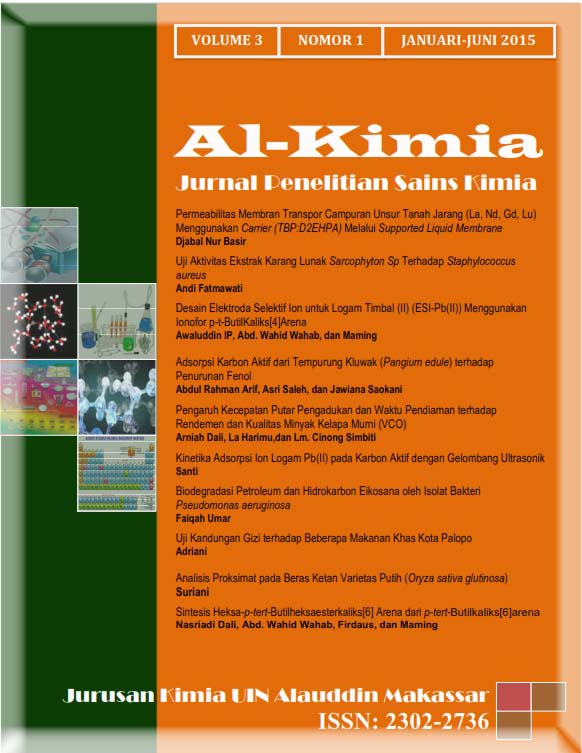Kinetika Adsorpsi Ion Logam Pb (II) pada Karbon Aktif dengan Gelombang Ultrasonik
Abstract
Adsorption capacity Increase of the activated carbon can be done with the use of ultrasonic energy-producing high chemical. Activated carbon is used to absorb the metals Pb(II) with a variety of time. Research purposes to determine the effect of variation of contact time on the adsorption of Pb(II) using rice husk activated carbon irradiated with ultrasonic waves and without irradiation. Determining the reaction kinetics model (reaction order and k values) of Pb (II) using rice husk activated carbon irradiated with ultrasonic waves. The results showed the optimum time on the adsorption process of Pb(II) by rice husk activated carbon is irradiated with ultrasonic waves were 50 minutes, whereas the adsorption process of Pb (II) by rice husk activated carbon without irradiated with wave ultrasonic is 30 minutes. Reaction kinetics of Pb(II) according to the pseudo-second-order kinetic model and the value of k2 = 0.0472 g. mg-1.min-1.
Downloads
References
Alberty RA, Silbey RJ, 1992, Physical Chemistry, Ed ke-1, New York: J Wiley.
Anshar. A. M., 2012, Adsorbsi Fenol dan 2-Klorofenol Menggunakan Karbon Aktif Dari Sekam Padi, Tesis tidak diterbitkan, Makassar: UNHAS.
Arnawaty, A., 2012, Adsorpsi Metilen Biru dan Eosin Menggunakan Karbon Aktif dari Sekam Padi, Tesis tidak diterbitkan, Makassar: UNHAS.
Blais, J.F., Dufresne, B., dan Mercier G., 2000, State of The Art of Technolgies for Metal Removal from Industrial Effluents, Rev, Sci, Eau, 12(4): 687-711.
Edwin. W., 2005, Pemanfaatan Karbon Aktif Tempurung Kenari Sebagai Adsorben 4-klorofenol Dalam Air, Skripsi tidak diterbitkan, Makassar: UNHAS.
Hartini, H, 2008, Pemanfaatan Abu Sekam Padi dan Karbon Aktif Sebagai Media Filter Terhadap Air Limbah Cold Storage, Tesis tidak dierbitkan, Makassar: Program Pasca Sarjana UNHAS Makassar.
Ihwan. M. K, 2008, Pembuatan Asap Cair dari Pembakaran Batu Bata Menjadi Pestisida dan Pengawet Organik, Laporan Kegiatan Pengembangan Inovasi Pertanian Melalui Inisiatif Local Poor Farmer Income Improvement Throught Innovation.
Kannan N., Mariappan Meenakshi Sundaram, 2001, Kinetics and Mechanism of Removal of Methylene Blue by Adsorption on Various Carbons-a Comparative Study, J. Dyes and Pigments, 51: 25-40.
Milenkovic D.D., Dasic P.V., Veljkovic V.B., 2009, Ultrasound-assisted Adsorption of Copper(II) Ions on Hazelnut Shell Activated Carbon, Ultrason. Sonochem., 16: 557-563.
Malik, P. K., 2002, Use of Activated Carbons Prepared from Sawdust and Rice- husk for Adsorption of Acid Dyes: A Case Study of Acid Yellow 36, J. Dyes and Pigments, 56: 239-249.
Nordberg G. F., Fowler B. A., Nordberg M. and Friberg L., 2005, Handbook on the Toxicology of Metals, 3th Edition, European Environment Agency.
Popuri et. al., 2007, Biosorption of Hexavalent Chromium Using Tamarind (Tamarindus Indica) Fruit Shell-a Comparative Study, E. J. Tech., 10(3).
Suslick, K. S, 1990, Sonochemistry, Science, 247: 1439-1445.
Winaya, I. S, 2008, Prospek Energi dari Sekam Padi dengan Teknologi Fluidized Bed Combustion, Inovasi Online, Edisi XX, Vol. 11.
Authors who publish with this journal agree to the following terms:
1) Authors retain copyright and grant the journal right of first publication with the work simultaneously licensed under a Creative Commons Attribution License that allows others to share the work with an acknowledgement of the work's authorship and initial publication in this journal.
2) Authors are able to enter into separate, additional contractual arrangements for the non-exclusive distribution of the journal's published version of the work (e.g., post it to an institutional repository or publish it in a book), with an acknowledgement of its initial publication in this journal.
3)Authors are permitted and encouraged to post their work online (e.g., in institutional repositories or on their website) prior to and during the submission process, as it can lead to productive exchanges, as well as earlier and greater citation of published work (See The Effect of Open Access).


